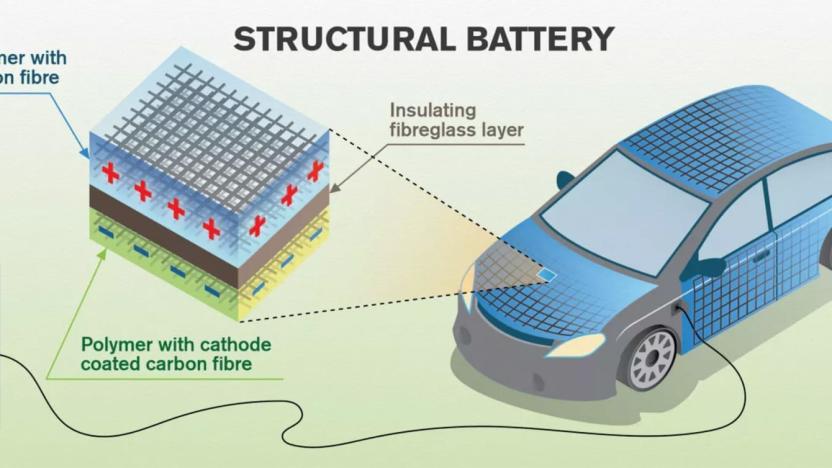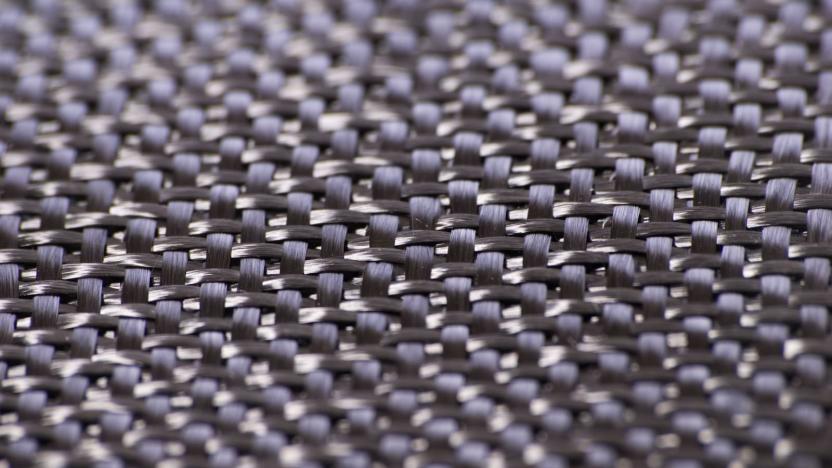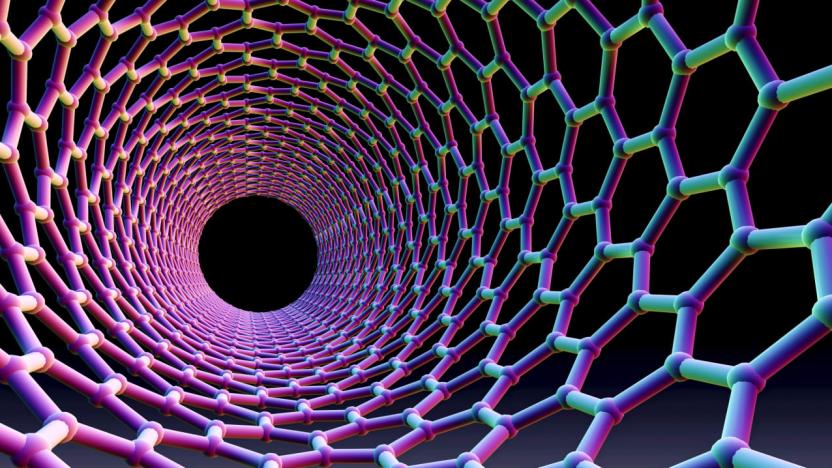carbonfiber
Latest

Electric cars could store energy in their carbon fiber bodies
Electric cars typically need larger, denser batteries if they're going to meet the range expectations of people used to gas-powered vehicles, but available space and weight limit the size of that battery. Researchers might have a solution: turn the very body of the car into a battery. They've conducted a study showing that carbon fiber shells could serve as battery electrodes. The trick is to optimize the size and orientation of the fibers so there's a good balance between stiffness and the electrochemical traits needed to store energy.
Jon Fingas10.21.2018
Lowe's exoskeletons help workers carry what you can't
Exoskeletons aren't just for shipyard workers or people with limited mobility. If Lowe's has its way, they'll help store staff fetch your giant bucket of paint. The home improvement retailer has partnered with Virginia Tech to test prototype passive exoskeletons that make it easier to haul heavy objects. Carbon fiber in the suits' back and legs serves as a "taut bow" that stores energy when you bend down -- that energy comes back the moment you stand back up, making it much easier to lift that heavy bag of concrete. The material's flexible nature should also help the suits feel relatively comfortable... a rather important consideration for warehouse workers who may need to wear it for an entire shift.
Jon Fingas05.16.2017
Chaos leads to stronger carbon fiber
Carbon fiber is widely used in aircraft and performance cars thanks to its light-yet-strong nature, but it's still a fuzzy science. What's the ideal baking temperature, and the resulting degree of chaos in carbon atoms, that you need to make the sturdiest material? MIT might finally have an answer. Its researchers have discovered a link between the random order of carbon atoms in a baked resin and its consequent density and strength. And by doing so, they've found an ideal baking temperature that makes the carbon as random (and thus as light and strong) as possible.
Jon Fingas03.20.2017
White House plan will train coal workers for 21st century jobs
Stepping away from fossil fuels is incredibly important, but our move toward a sustainable future will invariably leave countless workers unemployed by no fault of their own. The White House knows this and this week, the Obama administration announced $28 million in funding for 42 "economic and workforce" development programs across a baker's dozen of (mostly southern) states.
Timothy J. Seppala10.29.2016
Carbon fiber strings protect buildings against earthquakes
The problem with earthquake-proofing a building is that it usually involves grafting on a lot of support -- not really an option with historic buildings or other particularly delicate structures. Komatsu Seiren Fabric Laboratory might have a better way, however. Its carbon fiber-based CABKOMA Strand Rods can protect a building against quakes by tying the roof to the ground, making sure that the whole building moves together -- and thus stays together -- during a tremor. The fibers are both very strong and very light (you can easily carry a 520-foot strand by yourself), so it's more like draping spiderwebs over a building than anchors.
Jon Fingas04.13.2016
Carbon nanotube film is stronger and stretchier than kevlar
Researchers at East China University of Science & Technology have finally managed to develop a macroscopic material that exhibits the same strength and pliability as individual nanotubes. In fact, their new carbon nanotube-based film that is five times stronger and 8 percent more pliable than any such material previously developed.
Andrew Tarantola02.03.2016
Omate Rise is a circular Android 3G smartwatch for just $200
Omate probably isn't the first brand that comes to mind when you think of smartwatches, but the truth is it was one of the first to launch a 3G-enabled smartwatch. It's been over two years since then but such devices have yet to fully take off, not to mention that LG has recently canned its latest LTE watch. But that's good news for Omate who is launching the Rise, a $200 fully circular smartwatch, via Indiegogo on December 7th. Much like its predecessor, the Rise runs on full Android 5.1 (customized with Omate's new OUI 4.0) instead of Android Wear, meaning you can side load any regular Android app -- including all the missing Google Play services -- onto it. But of course, you'll have to get used to poking around on that 1.3-inch, 360 x 360 round LCD. Additionally, the Rise also works as a notification watch with phones running on either iOS 9 or Android 4.4 and above.
Richard Lai12.01.2015
Dell will use recycled carbon fiber in Alienware and Latitude products
Later this year, Dell will increase the amount of recycled materials that it uses to make its products. Before the end of 2015, the company will begin using excess carbon fiber and other scrap materials in a few Alienware and Latitude devices. The effort with expand across those two lines in 2016 as the Dell says its plan to use the recycled carbon fiber is "an industry first." The company is teaming up with the supplier SABIC on the initiative, and it says estimates show the duo can keep 820,000 pounds of carbon fiber from hitting landfills. The computer maker began using recycled plastics for enclosures back in 2014, re-using 4.2 million pounds since that time in a number of displays and its OptiPlex desktops.
Billy Steele09.28.2015
Researchers pluck carbon from the sky, turn it into diamonds
Carbon's the perfect material to build strong yet lightweight materials, but it's also the reason we're running head-first into an ecological apocalypse. Wouldn't it be great if we could snatch the excess CO2 from the air and use it to cheaply build aircraft fuselages, modern cars and artificial synthetic diamonds? That's what a group of researchers from George Washington University claim to have achieved at a recent meeting of the American Chemical Society. Not only would it mean that future engineering projects would have an abundant source of cheap materials, but it also has planet-saving consequences.
Daniel Cooper08.20.2015
A $1,495 toaster oven takes the guesswork out of cooking
It may look like the toaster oven that you fed yourself with that time you were on the lam and hiding in a seedy motel, but this could be the future of cooking. Meet June, a tabletop oven that combines cutting-edge heating elements, clever sensors and smartphone technology to build "the computer... that cooks." Technology-wise, there's an NVIDIA Tegra K1 chip with a 2.3GHz quad-core processor paired with a 5-inch touchscreen and a "full HD" camera that's been embedded in the ceiling. You guessed it: the camera is for posting pictures of your culinary concoctions to Instagram.
Daniel Cooper06.09.2015
Department of Energy 3D prints an all-electric Shelby Cobra
Carroll Shelby's iconic Cobra roadster has been making jaws drop for half a century now. To celebrate the 50th anniversary of the Cobra's debut the US Department of Energy built one of its own. The new Cobra's entire chassis and bodywork--from the passenger monocoque to the grille and headrests--were 3D printed from carbon fiber reinforced ABS using the Big Area Additive Manufacturing (BAAM) machine at Oak Ridge National Laboratory. And while the exterior of the new Cobra is nearly indistinguishable from its predecessor, they look nothing alike under the hood. The DoE's Cobra is, in fact, completely electric.
Andrew Tarantola04.30.2015
Mark One 3D printer creates carbon fiber objects, costs $5,000
There's a new 3D printer in town, and unlike other models that use plastic, rubber or even chocolate, this one prints out objects using a far tougher material: carbon fiber. The printer, named Mark One, was designed by creator Gregory Mark as a way to reduce carbon fiber manufacturing costs. He sees Mark One as a way to make useful things like tools, replacement parts or even home fixtures, though nothing would stop you from printing out super-durable toys and knick-knacks, too. Of course, carbon fiber raw materials may not be so easy to come by, so Mark's creation also works with other composites, like fiberglass, nylon and PLA plastic. Those who want to make tough little trinkets (and have $5,000 to spare) will have to wait until March to pre-order the Mark One, but folks in San Diego can see it in person right now at the SolidWorks World convention.
Mariella Moon01.29.2014
Proporta carbon fiber iPhone case gets the shotgun treatment, survives
We've heard of Lightning charge cables being able to deflect bullets, but here's an iPhone 5/5s case that's built with a carbon fiber lining that can take a shotgun blast at 20 yards. Proporta's Leather Case with Carbon Fiber Lining (US$59.95) takes a blast from "Uncle Barry's shotgun" and is none the worse for wear when it is recovered by the film crew. The company also has an iPad mini with Retina display case that has survived the shotgun test. If you happen to be going out duck hunting with someone who has lousy aim, it might be worth it to buy a bunch of these and place them around your body... Just sayin'.
Steve Sande11.08.2013
Ridiculously thin and light laptop unveiled in Taiwan: the 10.7mm, 1.9-pound Inhon Blade 13 Carbon
Never heard of Inhon? That might change with the Taiwanese computer maker's Blade 13 Carbon laptop, which it claims is now the world's thinnest and lightest. Tipping the scale at 870g (1.9 pounds) and 10.7mm, the company says it undercuts NEC's 12.8mm Lavie X by a whopping 2mm, while nipping the 875g LaVie Z by 5g. There are still weighty specs crammed into the package, however: a Core i5 or i7 CPU, 1080p screen, 128GB or 256GB SSD and 4GB of RAM. If you're looking for that kind of unencumbered power, the Carbon will also lighten your pocketbook to the respectable tune of $1,350, while a dialed-back 1,600 x 900 fiberglass version -- still radically lean at 12.6mm and 1,195g (2.6 pounds) -- will run a grand or so. These models will arrive in Taiwan in June, with no sign that it'll come to relieve us overburdened laptop users stateside. %Gallery-186195%
Steve Dent04.19.2013
This is the carbon fiber core of Ferrari's first hybrid
Ferrari has already said that it will never make an electric car -- at least, not while Luca di Montezemolo is in charge -- but we already know that a hybrid Ferrari is in the cards. And, this is what will hold it all together. At this year's Paris Auto Show the company rolled out this carbon fiber cage that is the core chassis of the machine. Other than a pledge that the thing will use F1-inspired technology nobody would tell us what it would be called (possibly F70, at least internally) or just when the rest of its components will be bolted on. But, for now, enjoy this sneak peek under the skin of Ferrari's next hypercar. Steve Dent contributed to this report.
Tim Stevens09.28.2012
BMW i3 sheds its skin, shows off carbon skeleton
Want to know how the BMW i3 electric car can be so light (2,800 pounds) despite hauling around a massively heavy battery pack? A lot of it has to do with its carbon chassis. BMW uses something called CFRP (carbon fiber reinforced plastic) to create a material that is light, strong and, crucially, cheap enough to actually be used in production. The car is still on track for its 2013 release, where it will be sold out of posh i Stores like the one recently opened in London. Steve Dent contributed to this post.
Tim Stevens09.27.2012
Roskva electric motorcycle revealed in Norway with carbon fiber chassis and clothes
The choices in the electric motorcycle market just keep getting juicier, and while you'll still have to stick with the more established brands like Brammo, Zero or BRD if you're looking to make a purchase, a hot new prototype has just been unveiled that threatens to make them all look a little bit... pedestrian. It's called the Roskva from a team of five students at the University of Life Sciences (UMB) in Oslo, Norway. Like a MotoGP bike it has an all carbon fiber unified frame and bodywork that weighs less than 25kg and even rolls on carbon wheels. A 94HP motor provides the oomph and delivers a top speed of about 112MPH, with a maximum range of 62 miles. No word on when or if the thing might make it into actual production, but we can say for sure that there's a second picture of the thing just waiting for you right after the break, still in that same garage that is far, far neater than ours. [Image credit: Henrik Holmberg]
Tim Stevens07.08.2012
FlyNano proto takes to the air, final model will soar mainly with electrons (video)
Last time we saw the FlyNano amphibious ultralight plane, we weren't sure if it would be gas or electric, and we wondered who'd be brave enough to fly the tiny thing -- if it flew at all. That's all been answered, because the sub-154 pound carbon fibre vehicle completed its first flight, taking a brief skip above a Finnish lake with pilot Pekka Kauppinen at the helm. The short trip showed promise, and the company affirmed it would continue development and airborne tests with the aim of delivering to customers in late 2013. According to the maker, recent technology gains mean that electric motors will now be the main power option. No change to the $27k base price tag was announced, so if you've got the nerve to strap one on -- and a lake to launch from -- click the source or watch the video after the break.
Steve Dent06.16.2012
Gigabyte makes 975g X11 official, claims 'world's lightest' 11.6-inch notebook (update: hands-on video)
Well hello there again, Gigabyte X11. Hot on the heels of yesterday's leak, Gigabyte's just made its 11.6-inch X11 laptop (or is that an Ultrabook?) official. At 975g (2.15 pounds) it claims the title of "lightest notebook on earth" -- and weighs even less on Mars. Design-wise, you're looking at a 16.5mm (0.65 inches) to 3mm (0.19 inches) thin Macbook Air-like body made of real carbon fiber (!) with an aluminum hinge. Under the hood you'll find unspecified third generation Intel Core processors (read Ivy Bridge), 4GB of DDR3 RAM, Mobile Intel HM77 Express chipset with Intel HD Graphics 4000, a 128GB SSD, WiFi b/g/n and Bluetooth 4.0. Ports include power, USB 2.0 and mini DisplayPort on the left side plus microSD, combo audio and USB 3.0 on the right. While the specs also mention gigabit Ethernet, there's no sign of it anywhere in the press shots. The display is a 1366x768-pixel LED-backlit affair dotted with a 1.3 megapixel webcam. A chiclet keyboard, buttonless trackpad and 4730mAh 7.4V Li-ion polymer battery (likely sealed) complete the package. There's no word on availability, but prices will range from $999 to $1299 with Windows 7 Home Premium and Professional in tow. Expect more information when we get our hands on this sexy beast at Computex next week. Update: Our colleagues over at Engadget Chinese just got to spend some time with this svelte black slab. Take a look at the gallery below and hit the break for the hands-on video.%Gallery-156515% %Gallery-156511% In addition, Gigabyte's announcing two 14-inch laptops -- the U2442 and U2440 -- which feature third generation Intel Core processors and NVIDIA GeForce graphics. Unfortunately, we're still busy drooling all over the X11 gallery, so we'll direct you to the full PR after the break for the complete details. Andy Yang contributed to this report.
Myriam Joire05.31.2012
Gigabyte to unveil X11 on May 31st as lightest laptop ever, spooks us with talk of 'sixth element'
Gigabyte is clearly hoping to carve out a name for itself in a very crowded ultraportable space; it sent us word of a media event for a new X11 laptop in its native Taipei on May 31st, just a few days ahead of Computex. The PC designer claims that the X11 will be the "lightest notebook on Earth," a pretty audacious claim considering the featherweight competition. Most of the braggadocio, we suspect, is rooted in the choice of material: Gigabyte is promising rather ominously to "conquer the 6th element," and unless it's financing the sequel to a Luc Besson movie, we're reasonably sure the firm means extra-light carbon fiber. Other details are scarce, including whether there's any relation to the U2442 Ultrabook due this summer. We'll know in just over a week.
Jon Fingas05.23.2012